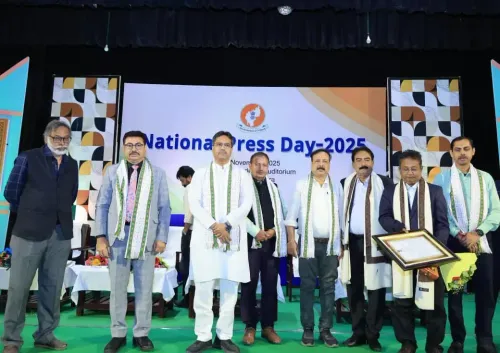How is GST 2.0 Transforming Livelihoods and Growth in Uttar Pradesh?

Synopsis
Key Takeaways
- GST reforms provide targeted relief to artisans.
- Lower tax rates improve affordability for consumers.
- Key industries include carpets, ceramics, and sports goods.
- Support for MSMEs enhances local economic growth.
- Women artisans benefit significantly from these reforms.
New Delhi, Oct 2 (NationPress) The latest GST reforms are set to provide essential relief to the diverse economy of Uttar Pradesh, which includes GI-registered carpets, brassware, Zardozi, footwear, ceramics, sports goods, and cement. Lower tax rates are anticipated to enhance affordability for households, alleviate working-capital pressures on artisans, and boost the competitiveness of MSMEs in both domestic and international markets, as stated in an official announcement on Thursday.
The pricing of Bhadohi carpets, Moradabad brassware, and Saharanpur woodcraft is projected to decrease by 6–7 percent, which will enhance exports and sustain the livelihoods of lakhs of artisans. The Bhadohi–Mirzapur–Jaunpur area is recognized as one of India’s largest clusters for hand-knotted and handwoven carpets.
With the GST reduction from 12 percent to 5 percent, handmade carpets are expected to become more affordable. This change is likely to enhance domestic market accessibility, improve export competitiveness, and relieve the financial strain on family-owned looms and SMEs that dominate this cluster.
The leather and footwear sectors in the Kanpur–Agra region, employing approximately 1.5 million individuals, will also reap the benefits of the GST rate cut, which will bolster the competitiveness of MSMEs and lead to increased exports.
Additionally, the clusters of Firozabad glassware, Khurja ceramics, and Gorakhpur terracotta are poised to benefit from reduced costs, supporting fragile industries and festival demands as prices decline due to the GST reduction.
The cut in GST will also uplift Lucknow's Zardozi, a GI-registered craft and an ODOP-promoted product, providing livelihoods for around 1.5-2 lakh artisans, a significant portion of whom are women in small-scale units producing these embellished fabrics. This craft meets strong domestic demand from weddings and festivals and exports to the Middle East, Europe, and the USA.
Agra's renowned marble inlay craft (Parchinkari), passed down through artisan families in Agra, Firozabad, and Mathura, is closely associated with tourism. This cluster supports between 5,000 and 20,000 workers, including carvers, polishers, and inlay artists, many of whom benefit from ODOP initiatives.
The industry is intrinsically linked to tourism and decor markets, with additional sales through online gifting and niche exports to Europe and the Gulf. A GI application for Agra Parchinkari is currently under review, and the craft is internationally recognized for its connection to the Taj Mahal's heritage.
The GST reduction from 12 percent to 5 percent is expected to make stone handicrafts more affordable for tourists and local buyers, thereby increasing sales and alleviating cost pressures on small workshops.
Moreover, GST 2.0 will empower cottage-based and family-run units dominating Uttar Pradesh’s embroidery sector, with nearly 2.5–3 lakh artisans working across Lucknow, Varanasi, and Bareilly (as per NIFT and MSME reports).
Women represent a significant portion of the workforce, particularly in semi-urban and rural households. Lucknow Chikan Craft and Varanasi Zardozi Work are both recognized as GI-registered and ODOP products, receiving targeted promotional support.
The GST reforms will also invigorate the wooden toy and craft sector in Uttar Pradesh, sustained by family artisans who often work from home.
The clusters in Varanasi and Chitrakoot employ around 15,000–25,000 artisans, while Saharanpur hosts thousands more engaged in woodworking and carving. Rampur is also part of this traditional craft network. These clusters cater to robust domestic demand through fairs, religious toys, and decor, with modest exports reaching Europe and the Gulf.
With the GST reduction from 12 percent to 5 percent, toys and small crafts are expected to become more affordable, enhancing access in local markets and aiding artisans in competing against machine-made plastic products.
The GST reforms will further benefit the sports goods sectors in Meerut and Modinagar, where 30,000–35,000 workers are engaged in small units, MSMEs, and larger factories. This sector produces cricket and hockey equipment for a domestic market valued at approximately Rs 250 crore, while also exporting to the UK, Australia, Africa, and the Middle East. It is supported through ODOP with marketing and MSME assistance.
With the GST cut from 12 percent to 5 percent, sports goods are anticipated to become more affordable, likely boosting domestic demand, enhancing export competitiveness, and supporting employment stability across small and medium enterprises.
The GST reduction from 28 percent to 18 percent is likely to accelerate growth in Uttar Pradesh’s cement industry, which spans Mathura, Chunar (Mirzapur), Firozabad, and Aligarh, dominated by large-scale industrial plants. This sector employs about 15,000–20,000 direct workers and an additional 10,000 in transport, raw material supply, and construction-related services.
These clusters are situated in limestone-rich areas, ensuring efficient supply chains. While the domestic market is driven by housing, infrastructure, and construction, there are also limited clinker exports to Nepal and Bangladesh.
The GST rate reduction will make cement more affordable, lowering construction costs for developers and households, enhancing competitiveness against imports, and encouraging the expansion of industrial plants and logistics services.









